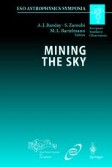Search
Search Results
-
One Year of NACO Operations
The first ESO adaptive optics system instrument, NACO, installed at the VLT has been offered to the astronomical community and used on a regular...
-
The Construction of X-ray Cluster Surveys and Their Spatial Analysis
The construction of X-ray cluster surveys is described. As an example the selection processes applied to the REFLEX survey and first results of an...
-
The 2dF QSO Redshift Survey - 10K@2K!
With $\approx$ 10000 QSO redshifts, the 2dF QSO Redshift Survey...
-
Clustering of X-Ray Selected AGN
The analysis of the spatial clustering of the brightest X-ray selected AGN from the ROSAT All Sky Survey is presented. A weak correlation signal at a...
-
Strong Constraints on Cosmology from Galaxy Clusters
In this work we show how galaxy clusters can be used to discriminate among different cosmological models. We have used available X-ray & optical...
-
Large-Scale Distribution and Spectral Properties of Galaxies in the Shapley Concentration
We present the results of a redshift survey of both cluster and intercluster galaxies in the central part of the Shapley Concentration, the richest...
-
FORCE: FORtran for Cosmic Errors
We review the theory of cosmic errors we have recently developed for count-in-cells statistics. The corresponding FORCE package provides a simple and...
-
Relating Galaxy Cluster X-Ray Luminosities to Gravitational Masses in Wide-Angle Surveys
The cosmologically most important cluster parameter is its gravitational mass. In order to constrain cosmological models of structure formation by...
-
Automated Classification Techniques for Large Spectroscopic Surveys
With the onset of large, systematically selected spectroscopic surveys we have the opportunity to understand the distribution and evolution of...
-
Fast Algorithms and Efficient Statistics: N-Point Correlation Functions
We present here a new algorithm for the fast computation of N-Point correlation functions in large astronomical data sets. The algorithm is based on...
-
Automatic Technique for Spectral Analysis
The paper puts forward two automatic methods to deal with astronomical spectra. An automatic classification method of stellar spectra using the Self...
-
Noise Estimation in CMB Time-Streams and Fast Iterative Map-Making
We describe here an iterative method for jointly estimating the noise power spectrum from a CMB experiment’s time-ordered data, together with the...
-
Source Identification Through Decision Trees
This paper presents the use of decision tree based techniques for optical / ultraviolet source identification. Such techniques allow to improve...
-
Mining the Thermal SZ Effect with a Speedy Pixon Algorithm
A Speedy Pixon Algorithm for image reconstruction is applied. Galaxy clusters are extracted from multi-wavelength microwave sky maps using the...
-
Extracting Knowledge from Very Large Datasets in a Multi-Wavelength Context
The ability to extract knowledge from very large data catalogues resulting from sky surveys or from deep wide fields, observed at various wavelength...
-
Splitting the Sky - HTM and HEALPix
Mission data sets are increasing in size and complexity. To enable efficient processing and storage of such data sets a tessellation scheme may be...
-
Case Study of Handling Scientific Queries on Very Large Datasets: The SDSS Science Archive
The SDSS Science Archive (SX) was designed to enable scientific data mining and interactive data exploration on the terabyte scale. It consists of a...
-
The Deepest Field
The Cosmic Microwave Background (CMB) anisotropy experiments are starting to map the last scattering surface at...
-
On the Evolution of Nearby Star-Forming Systems and Their Connection to Primeval Galaxies
We present the state of the art of a project to infer the spectro-photometric and chemical evolution history of some benchmark nearby star-forming...
-
Constraining Models of Galaxy Formation with Deep Multicolor Galaxy Surveys
We present a comparison between the observed properties of high redshift galaxies, as they result from the analysis of deep multicolor imaging...
